Spatio-Temporal Changes of Vegetation Net Primary Productivity and Its Driving Factors on the Qinghai-Tibetan Plateau from 2001 to 2017
Abstract
:1. Introduction
2. Materials and Methods
2.1. Study Area and Data
2.1.1. Study Area
2.1.2. Net Primary Productivity (NPP) Data
2.1.3. Meteorological Data
2.1.4. Digital Elevation Model Data
2.1.5. Human Footprint Dataset
2.2. Methods
2.2.1. Trend of NPP and Climate Data
2.2.2. Correlation between NPP and Climatic Factors
2.2.3. Stability Analysis
2.2.4. Cubic Spline Interpolation
3. Results
3.1. Spatio-Temporal Variation of NPP
3.1.1. Temporal Analysis of NPP Change
3.1.2. Spatial Analysis of NPP Change
3.2. Analysis of Influencing Factors of NPP Change
3.2.1. Influence of Climate on NPP
3.2.2. Influence of Altitude on NPP
3.2.3. Response of NPP Changes to Human Activities
4. Discussion
5. Conclusions
Author Contributions
Funding
Institutional Review Board Statement
Informed Consent Statement
Data Availability Statement
Acknowledgments
Conflicts of Interest
References
- Choudhury, B.J. Carbon use efficiency, and net primary productivity of terrestrial vegetation. Adv. Space Res. 2000, 26, 1105–1108. [Google Scholar] [CrossRef]
- Jassal, R.S.; Andrew Black, T.; Cai, T.; Morgenstern, K.; Li, Z.; Gaumont-Guay, D.; Nesic, Z. Components of ecosystem respiration and an estimate of net primary productivity of an intermediate-aged Douglas-fir stand. Agric. For. Meteorol. 2007, 144, 44–57. [Google Scholar] [CrossRef]
- Jiao, W.; Chen, Y.; Li, W.; Zhu, C.; Li, Z. Estimation of net primary productivity and its driving factors in the Ili River Valley, China. J. Arid Land. 2018, 10, 781–793. [Google Scholar] [CrossRef] [Green Version]
- Piao, S.; Fang, J.; Chen, A. Seasonal dynamics of terrestrial net primary production in response to climate changes in China. Acta Bot. Sin. 2003, 45, 269–275. [Google Scholar]
- Bondeau, A.; Kicklighter, D.W.; Kaduk, J. Comparing global models of terrestrial net primary productivity (NPP): Importance of vegetation structure on seasonal NPP estimates. Glob. Chang. Boil. 1999, 5, 35–45. [Google Scholar] [CrossRef]
- Turner, D.P.; Ritts, W.D.; Cohen, W.B.; Gower, S.T.; Running, S.W.; Zhao, M.; Costa, M.H.; Kirschbaum, A.A.; Ham, J.M.; Saleska, S.R.; et al. Evaluation of MODIS NPP and GPP products across multiple biomes. Remote Sens. Environ. 2006, 102, 282–292. [Google Scholar] [CrossRef]
- Chemodanov, A.; Jinjikhashvily, G.; Habiby, O.; Liberzon, A.; Israel, A.; Yakhini, Z.; Golberg, A. Net primary productivity, biofuel production and CO2 emissions reduction potential of Ulva sp. (Chlorophyta) biomass in a coastal area of the Eastern Mediterranean. Energy Conv. Manag. 2017, 148, 1497–1507. [Google Scholar] [CrossRef]
- Zhang, Y.; Qi, W.; Zhou, C.; Ding, M.; Liu, L.; Gao, J.; Bai, W.; Wang, Z.; Zheng, D. Spatial and temporal variability in the net primary production of alpine grassland on the Tibetan Plateau since 1982. J. Geogr. Sci. 2014, 24, 269–287. [Google Scholar] [CrossRef]
- Brasil, L.S.; Silverio, D.V.; Cabette, H.S.R.; Batista, J.D.; Vieira, T.B.; Dias-Silva, K.; de Oliveira-Junior, J.M.B.; de Carvalho, F.G.; Calvao, L.B.; Macedo, M.N.; et al. Net primary productivity and seasonality of temperature and precipitation are predictors of the species richness of the Damselflies in the Amazon. Basic Appl. Ecol. 2019, 35, 45–53. [Google Scholar] [CrossRef]
- Sun, H.; Zheng, D.; Yao, T.; Zhang, Y. Protection and construction of the national ecological security shelter zone on Tibetan Plateau. Acta Geogr. Sin. 2012, 67, 3–12. [Google Scholar]
- Wang, L.; Gong, W.; Zhang, M.; Ma, Y. Dynamic monitoring of vegetation NPP in Wuhan based on MODIS. Geom. Inf. Sci. Wuhan Univ. 2013, 38, 548–552. [Google Scholar]
- Zhou, W.; Sun, Z.; Li, J.; Gang, C.; Zhang, C. Desertification dynamic and the relative roles of climate change and human activities in desertification in the Heihe River Basin based on NPP. J. Arid Land. 2013, 5, 465–479. [Google Scholar] [CrossRef] [Green Version]
- Etherington, J.R. Environment and Plant Ecology; John Wiley & Sons: London, UK, 1989. [Google Scholar]
- Raich, J.W.; Rastetter, E.B.; Melillo, J.M.; Kicklighter, D.W.; Steudler, P.A.; Peterson, B.J.; Grace, A.L.; Moore, B., 3rd; Vorosmarty, C.J. Potential net primary productivity in south America: Application of a global model. Ecol. Appl. 1991, 1, 399. [Google Scholar] [CrossRef] [PubMed] [Green Version]
- Zhang, F.; Feng, Q.; Li, X.; Wei, Y. Remotely-sensed estimation of NPP and its spatial-temporal characteristics in the Heihe River Basin. Journal of Desert Research. Chin. J. Ecol. 2014, 34, 1657–1664. [Google Scholar]
- Zhu, Y.; Han, L.; Zhao, Y.; Ao, Y.; Li, J.; Xu, K.; Liu, B.; Ge, Y. Simulation and spatio-temporal pattern of vegetation NPP in northwest China. Chin. J. Ecol. 2019, 38, 1–13. [Google Scholar]
- Li, Y.; Pan, X.; Wang, C.; Liu, Y.; Zhao, Q. Changes of vegetation net primary productivity and its driving factors from 2000 to 2011 in Guangxi, China. Acta Ecol. Sin. 2014, 34, 5220–5228. [Google Scholar]
- Mao, D.; Wang, Z.; Han, J.; Ren, C. Spatio-temporal pattern of net primary productivity and its driven factors in northeast China in 1982–2010. Sci. Geogr. Sin. 2012, 32, 1106–1111. [Google Scholar]
- Liu, Y.; Zhang, J.; Zhang, C.; Xiao, B.; Liu, L.; Cao, Y. Spatial and temporal variations of vegetation net primary productivity and its responses to climate change in Shandong Province from 2000 to 2015. Chin. J. Ecol. 2019, 38, 1464–1471. [Google Scholar]
- Wang, L.; Niu, Z.; Kuang, D. An Analysis of the terrestrial NPP from 2002 to 2006 in China based on MODIS data. Remote Sens. Land Resour. 2010, 4, 113–116. [Google Scholar]
- Piao, S.; Fang, J.; He, J. Variations in vegetation net primary production in the Qinghai-Xizang Plateau, China, from 1982 to 1999. Clim. Chang. 2006, 74, 253–267. [Google Scholar] [CrossRef]
- Li, Q.; Zhang, C.; Shen, Y.; Jia, W.; Li, J. Quantitative assessment of the relative roles of climate change and human activities in desertification processes on the Qinghai-Tibet Plateau based on net primary productivity. Catena 2016, 147, 789–796. [Google Scholar] [CrossRef]
- Guo, B.; Han, B.; Yang, F.; Chen, S.; Liu, Y.; Yang, W. Determining the contributions of climate change and human activities to the vegetation NPP dynamics in the Qinghai-Tibet Plateau, China, from 2000 to 2015. Environ. Monit. Assess. 2020, 192, 663. [Google Scholar] [CrossRef]
- Yang, R.; Cao, G.; Cao, S.; Lan, Y.; Zhang, Z.; Chen, Z.; Chen, Z. Temporal and spatial variation of NPP and its response to climatic factors in main river valleys on the southern slope of Qilian Mountains. E3S Web Conf. 2019, 131, 1044. [Google Scholar] [CrossRef]
- Dong, J.; Xiao, X.; Menarguez, M.A.; Zhang, G.; Qin, Y.; Thau, D.; Biradar, C.; Moore, B., III. Mapping paddy rice planting area in northeastern Asia with Landsat 8 images, phenology-based algorithm and Google Earth Engine. Remote Sens. Environ. 2016, 185, 142–154. [Google Scholar] [CrossRef] [Green Version]
- Huang, H.; Chen, Y.; Clinton, N.; Wang, J.; Wang, X.; Liu, C.; Gong, P.; Yang, J.; Bai, Y.; Zheng, Y.; et al. Mapping major land cover dynamics in Beijing using all Landsat images in Google Earth Engine. Remote Sens. Environ. 2017, 202, 166–176. [Google Scholar] [CrossRef]
- Lobell, D.B.; Thau, D.; Seifert, C.; Engle, E.; Little, B. A scalable satellite-based crop yield mapper. Remote Sens. Environ. 2015, 164, 324–333. [Google Scholar] [CrossRef]
- Pekel, J.F.; Cottam, A.; Gorelick, N.; Belward, A.S. High-resolution mapping of global surface water and its long-term changes. Nature 2016, 540, 418–422. [Google Scholar] [CrossRef]
- Hansen, M.C.; Potapov, P.V.; Moore, R.; Hancher, M.; Turubanova, S.A.; Tyukavina, A.; Thau, D.; Stehman, S.V.; Goetz, S.J.; Loveland, T.R.; et al. High-resolution global maps of 21st-century forest cover change. Science 2013, 342, 850–853. [Google Scholar] [CrossRef] [Green Version]
- Yin, S.; Wu, W.; Zhao, X.; Gong, C.; Li, X.; Zhang, L. Understanding spatiotemporal patterns of global forest NPP using a data-driven method based on GEE. PLoS ONE 2020, 15, e0230098. [Google Scholar]
- Robinson, N.P.; Allred, B.W.; Smith, W.K.; Jones, M.O.; Moreno, A.; Erickson, T.A.; Naugle, D.E.; Running, S.W. Terrestrial primary production for the conterminous United States derived from Landsat 30 m and MODIS 250 m. Remote Sens. Ecol. Conserv. 2018, 4, 264–280. [Google Scholar] [CrossRef]
- Zou, F.; Li, H.; Hu, Q. Responses of vegetation greening and land surface temperature variations to global warming on the Qinghai-Tibetan Plateau, 2001–2016. Ecol. Indic. 2020, 119, 106867. [Google Scholar] [CrossRef]
- Hou, X.Y. 1:1,000,000 Vegetation Atlas of China; China Cartographic Publishing House: Beijing, China, 2001. [Google Scholar]
- Running, S.W.; Glassy, J.M.; Thornton, P.E. MODIS Daily Photosynthesis (PSN) and Annual Net Primary Production (NPP) Product (MOD17) Algorithm Theoretical Basis Document, 1999; 1–59.
- Ding, M. Temperature and Precipitation Grid Data of the Qinghai Tibet Plateau and Its Surrounding Areas in 1998–2017 Grid Data of Annual Temperature and Annual Precipitation on The Tibetan Plateau and Its Surrounding Areas During 1998–2017; National Tibetan Plateau Data Center: Beijing, China, 2019. [Google Scholar] [CrossRef]
- Rabus, B.; Eineder, M.; Roth, A.; Bamler, R. The shuttle radar topography mission-a new class of digital elevation models acquired by spaceborne radar. ISPRS J. Photogramm. Remote Sens. 2003, 57, 241–262. [Google Scholar]
- Duan, Q.; Luo, L. A dataset of human footprint over the Qinghai-Tibet Plateau during 1990–2015. Sci. Data Bank 2019. [Google Scholar] [CrossRef]
- Tian, Z.; Zhang, D.; He, X.; Guo, H.; Wei, H. Spatio-temporal variations in vegetation net primary productivity and their driving factors in Yellow River Basin from 2000 to 2015. Res. Soil Water Conserv. 2019, 26, 255–262. [Google Scholar]
- Mann, H.B. Nonparametric test against trend. Econometrica 1945, 13, 245–259. [Google Scholar] [CrossRef]
- Bartko, J.J. The Intraclass Correlation Coefficient as a Measure of Reliability. Psychol. Rep. 1966, 19. [Google Scholar] [CrossRef]
- Reed, G.F.; Lynn, F.; Meade, B.D. Use of Coefficient of Variation in Assessing Variability of Quantitative Assays. Clin. Diagn. Lab. Immunol. 2003, 10, 1162. [Google Scholar] [CrossRef] [Green Version]
- McKinley, S.; Levine, M. Cubic spline interpolation. Colg. Redw. 1998, 45, 1049–1060. [Google Scholar]
- THE MATHWORKS Inc. Signal Processing ToolboxTM: User’s Guide, Version 6.16 (Release 2018); The Mathworks Inc.: Natick, MA, USA, 2018. [Google Scholar]
- Evans, J.D. Straightforward Statistics for the Behavioral Sciences; Brooks/Cole Publishing: Pacific Grove, CA, USA, 1996. [Google Scholar]
- Yang, Y.; Piao, S. Variations in grassland vegetation cover in relation to climatic factors on the Tibetan plateau. J. Plant Ecol. 2006, 30, 1–8. [Google Scholar]
- Ye, C.; Sun, J.; Liu, M.; Xiong, J.; Zong, N.; Hu, J.; Huang, Y.; Duan, X.; Tsunekawa, A. Concurrent and lagged effects of extreme drought induce net reduction in vegetation carbon uptake on Tibetan Plateau. Remote Sens. 2020, 12, 2347. [Google Scholar] [CrossRef]
- Tao, B.; Li, K.; Shao, X.; Cao, M. Temporal and spatial characteristics simulation of net primary productivity in China. Acta Geogr. Sin. 2003, 3, 372–380. [Google Scholar]
- Yao, Y.; Yang, J.; Wang, R.; Lu, D.; Zhang, X. Responses of net primary productivity of natural vegetation to climatic change over source regions of Yangtze River in 1959–2008. J. Glaciol. Geocryol. 2011, 33, 1286–1293. [Google Scholar]
- Niu, T.; Chen, L.; Zhou, Z. The characteristics of climate change over the Tibetan Plateau in the last 40 years and the detection of climatic jumps. Adv. Atmos. Sci. 2004, 21, 193–203. [Google Scholar] [CrossRef]
- Rangwala, I.; Miller, J.R. Climate change in mountains: A review of elevation-dependent warming and its possible causes. Clim. Chang. 2012, 114, 527–547. [Google Scholar] [CrossRef]
- Deji, Y.; Lu, X. Net primary productivity of Tibetan Plateau vegetation and its response to climate change. Green Technol. 2013, 10, 4–6. [Google Scholar]
- Gao, Y.; Zhou, X.; Wang, Q.; Wang, C.; Zhan, Z.; Chen, L.; Yan, J.; Qu, R. Vegetation net primary productivity and its response to climate change during 2001–2008 in the Tibetan Plateau. Sci. Total Environ. 2012, 444, 356–362. [Google Scholar] [CrossRef]
- Guo, B.; Zang, W.; Yang, F.; Han, B.; Chen, S.; Liu, Y.; Yang, X.; He, T.; Chen, X.; Liu, C.; et al. Spatial and temporal change patterns of net primary productivity and its response to climate change in the Qinghai-Tibet Plateau of China from 2000 to 2015. J. Arid Land. 2020, 12, 1–17. [Google Scholar] [CrossRef] [Green Version]
- García-Romero, A.; Aceves-Quesada, J.F.; Arredondo-León, C. Landform instability and land-use dynamics in tropical high mountains, Central Mexico. J. Mt. Sci. 2012, 9, 414–430. [Google Scholar] [CrossRef]
- Garcia-Aguirre, M.; Ortiz, M.; Zamorano, J.; Reyes, Y. Vegetation and landform relationships at Ajusco volcano Mexico, using a geographic information system (GIS). For. Ecol. Manag. 2007, 239, 1–12. [Google Scholar] [CrossRef]
- Xu, Z.; Zhang, Y.; Cheng, S.; Zheng, D. Scientific basis and the strategy of sustainable development in Tibetan Plateau. Sci. Technol. Rev. 2017, 35, 108–114. [Google Scholar]
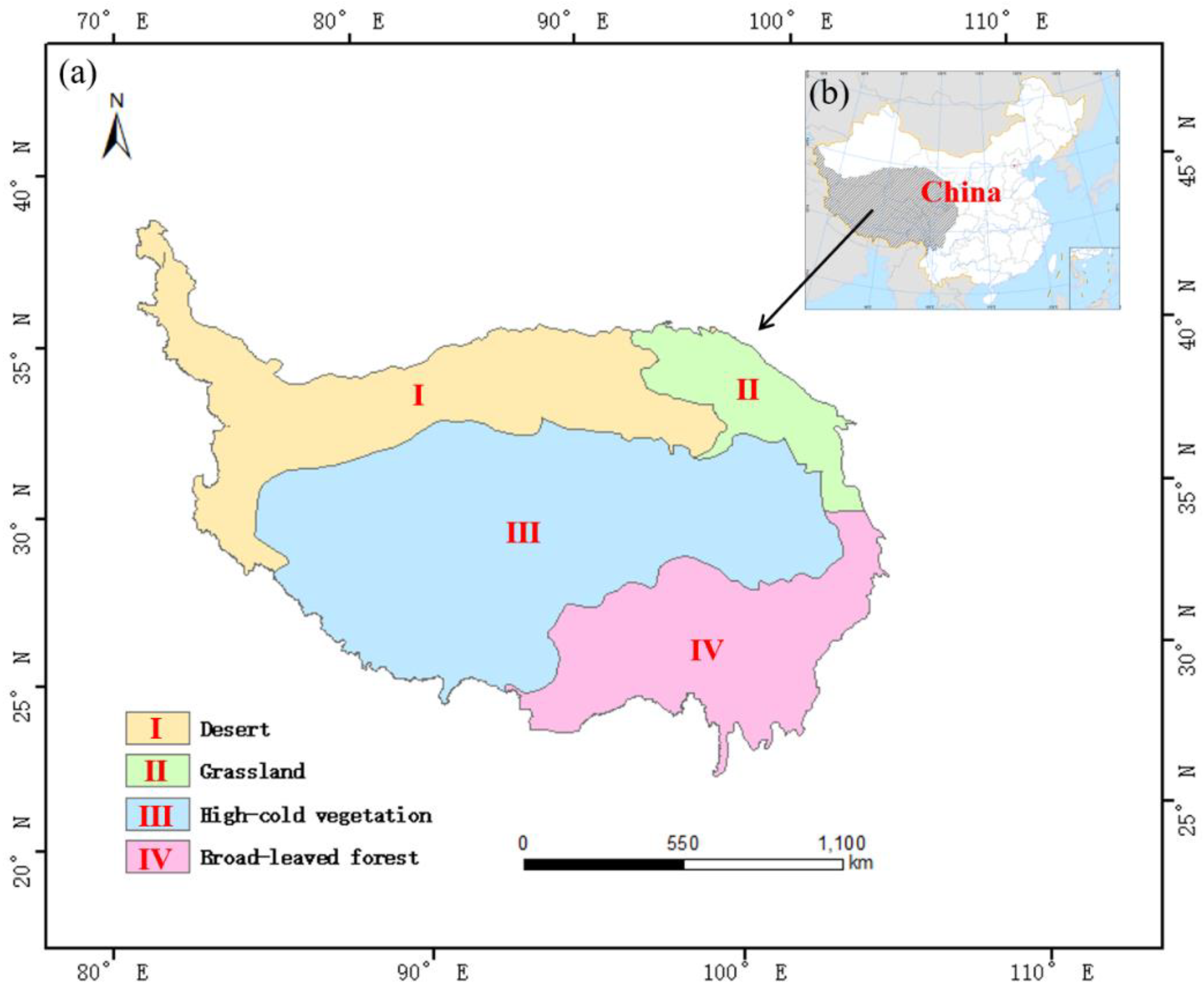
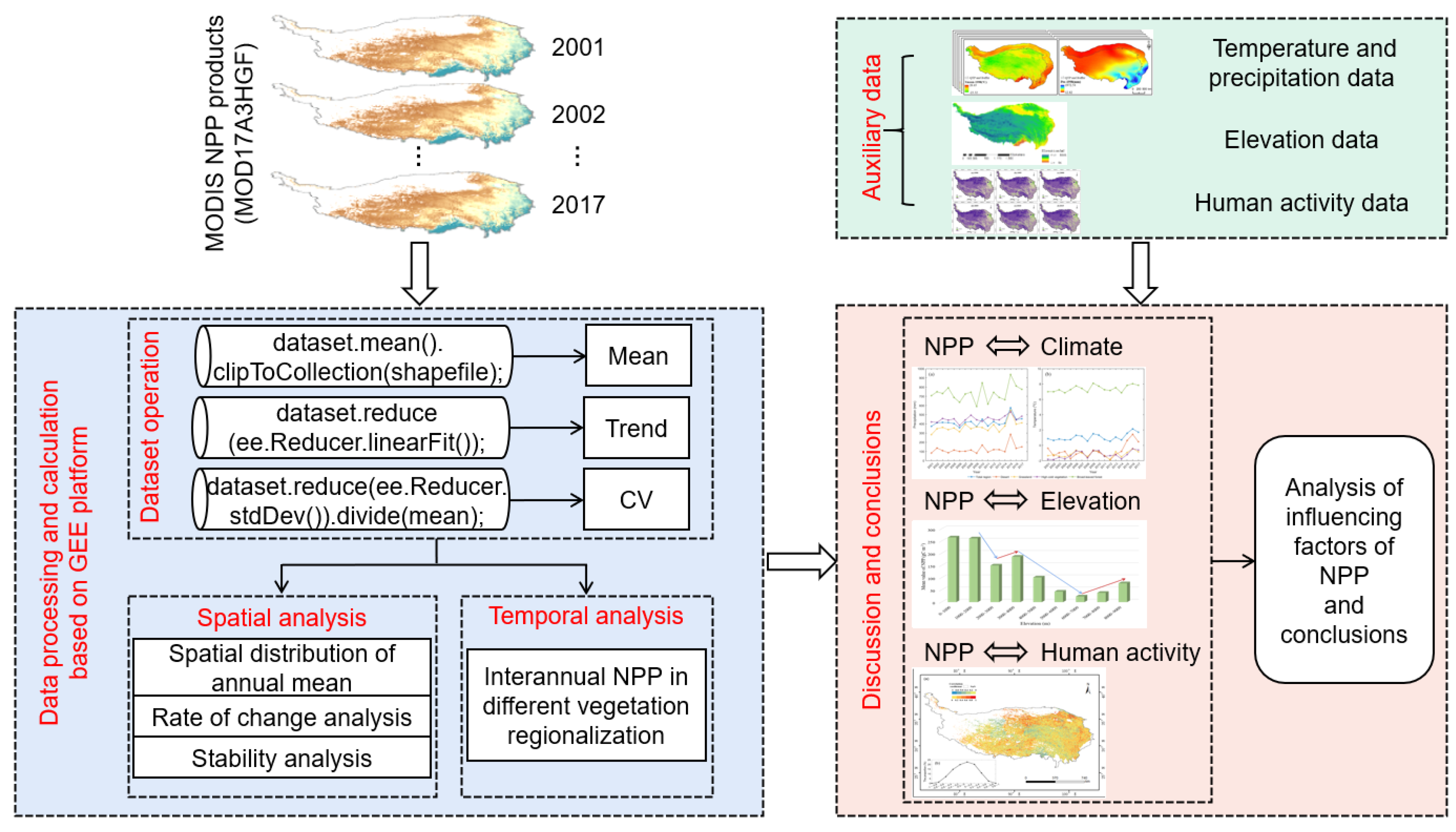
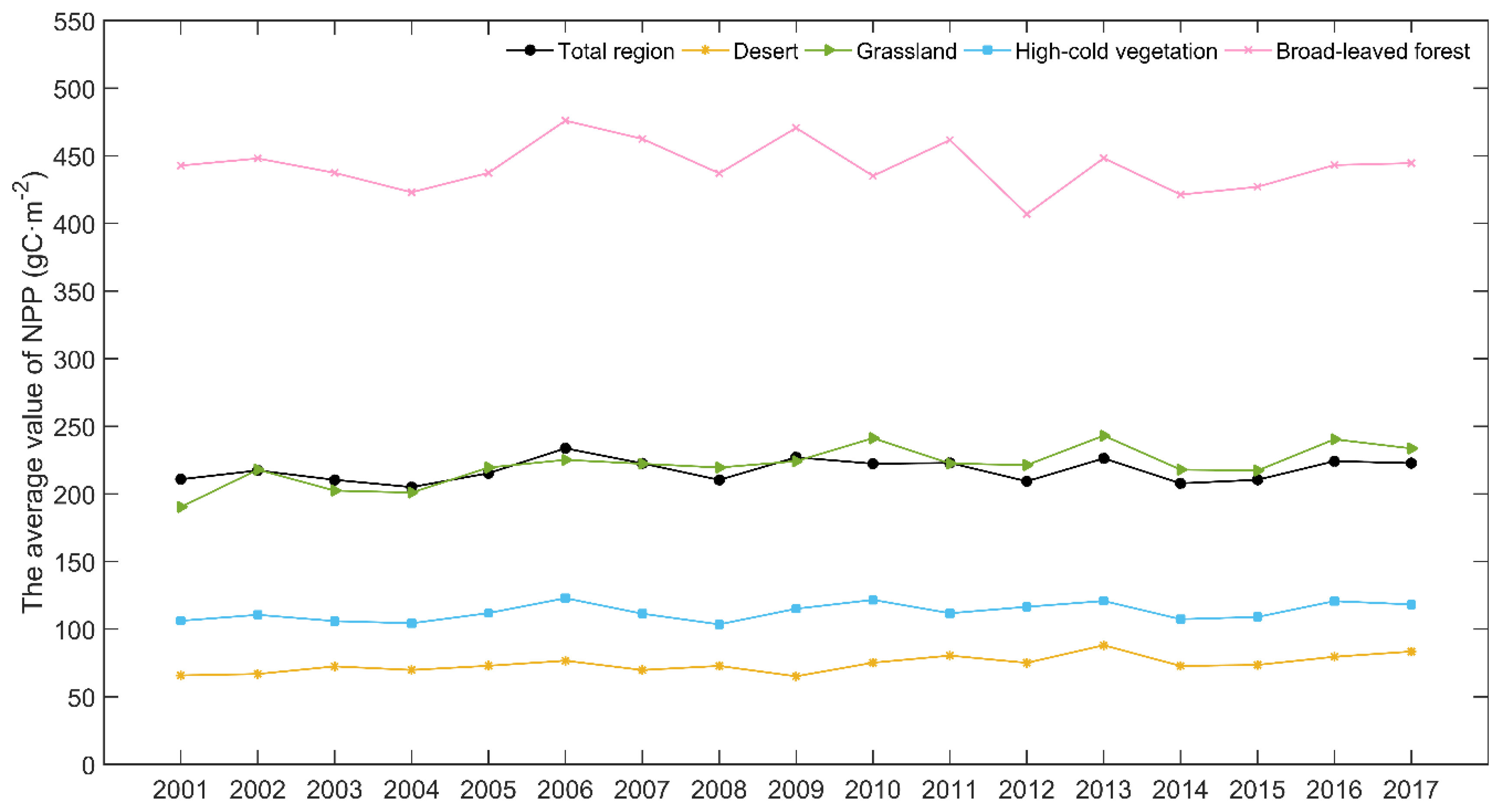
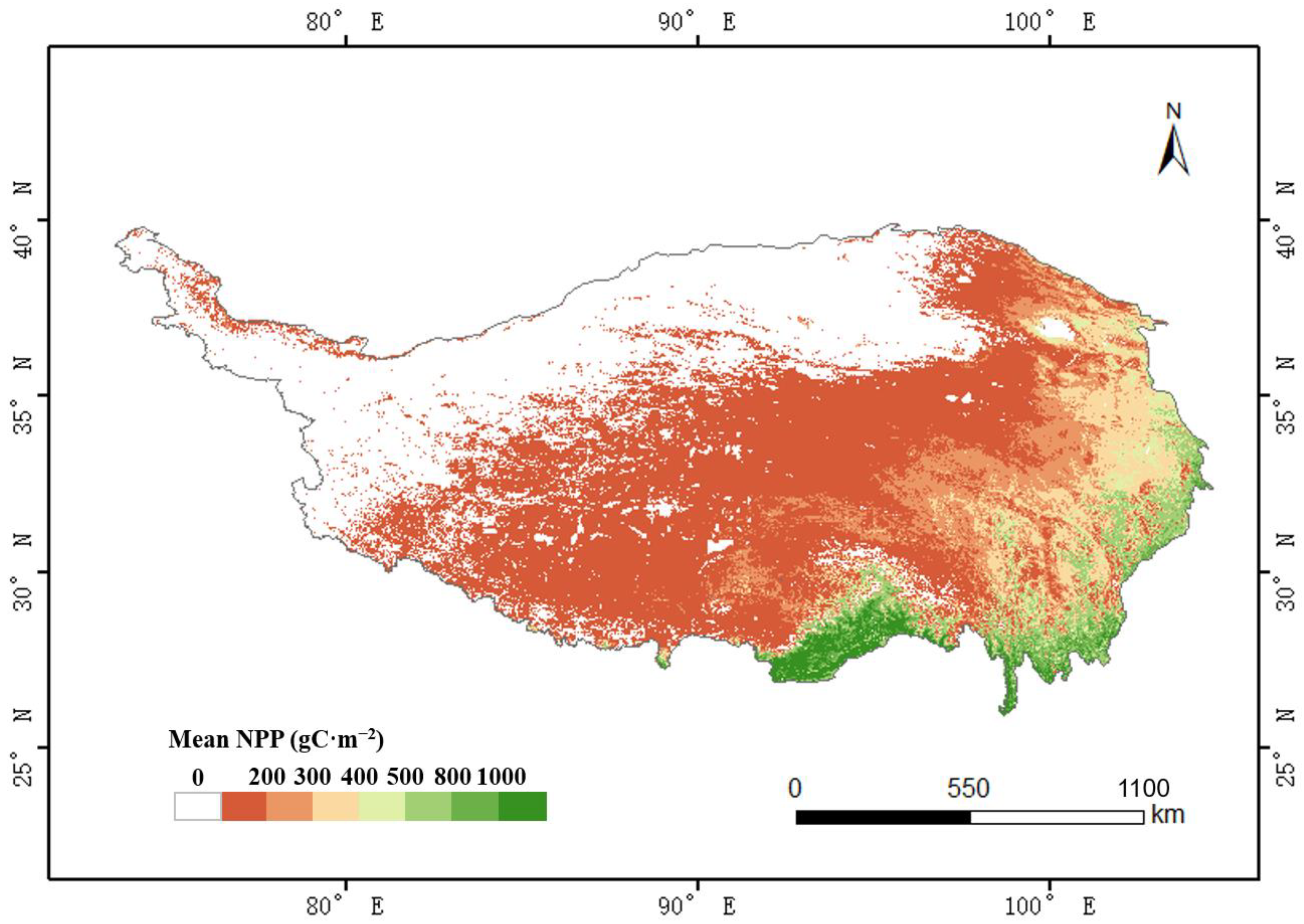

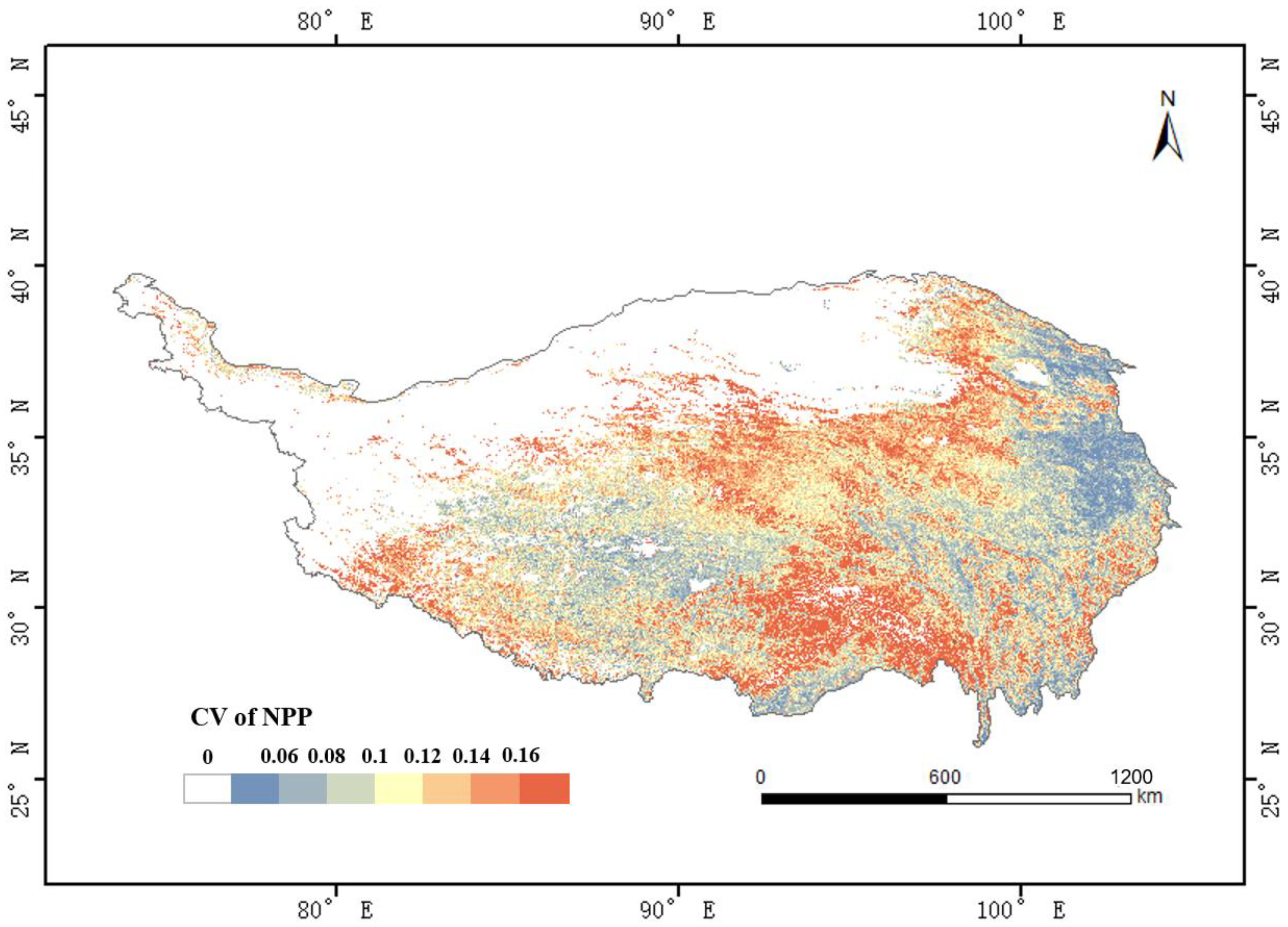

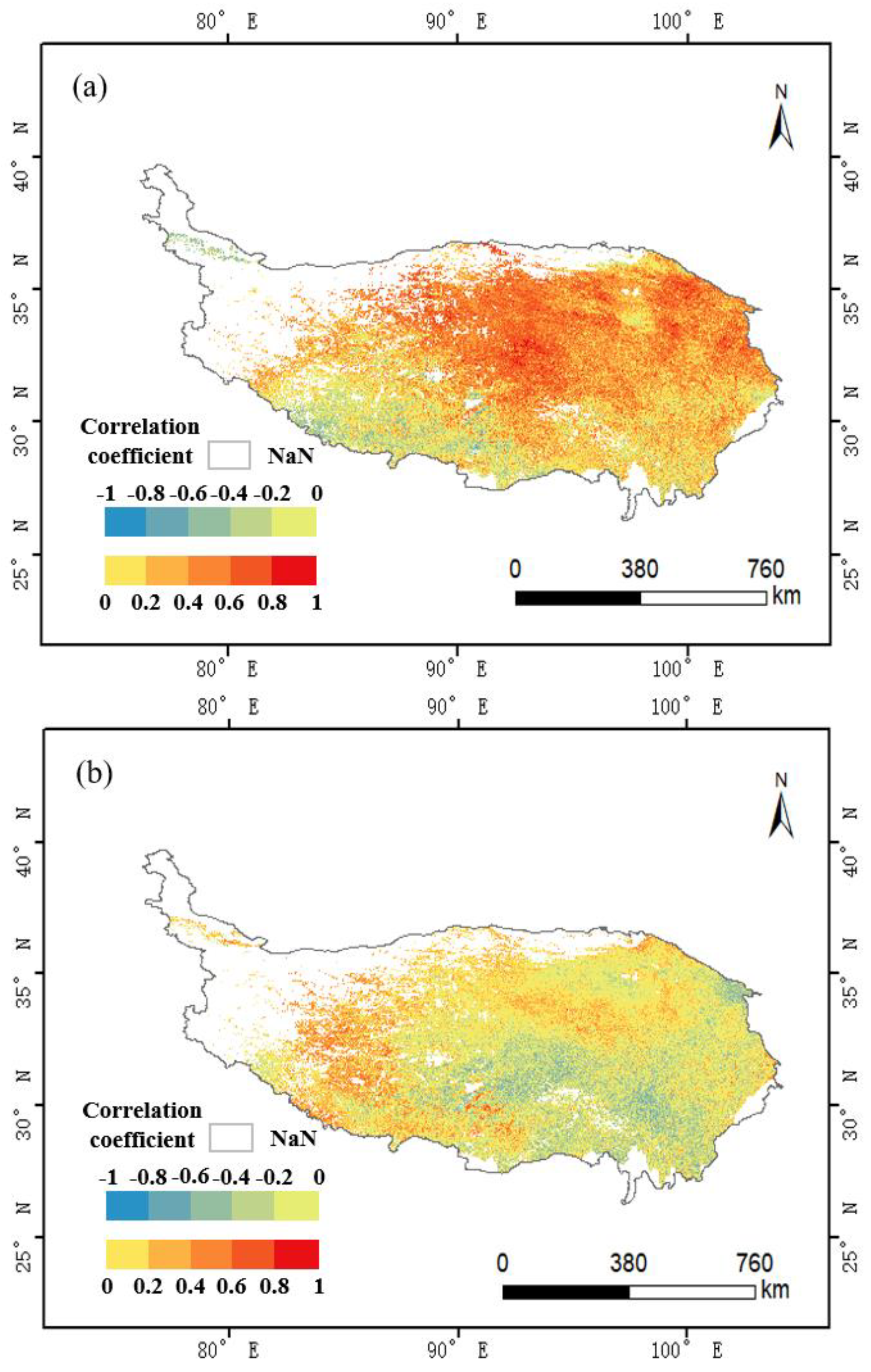
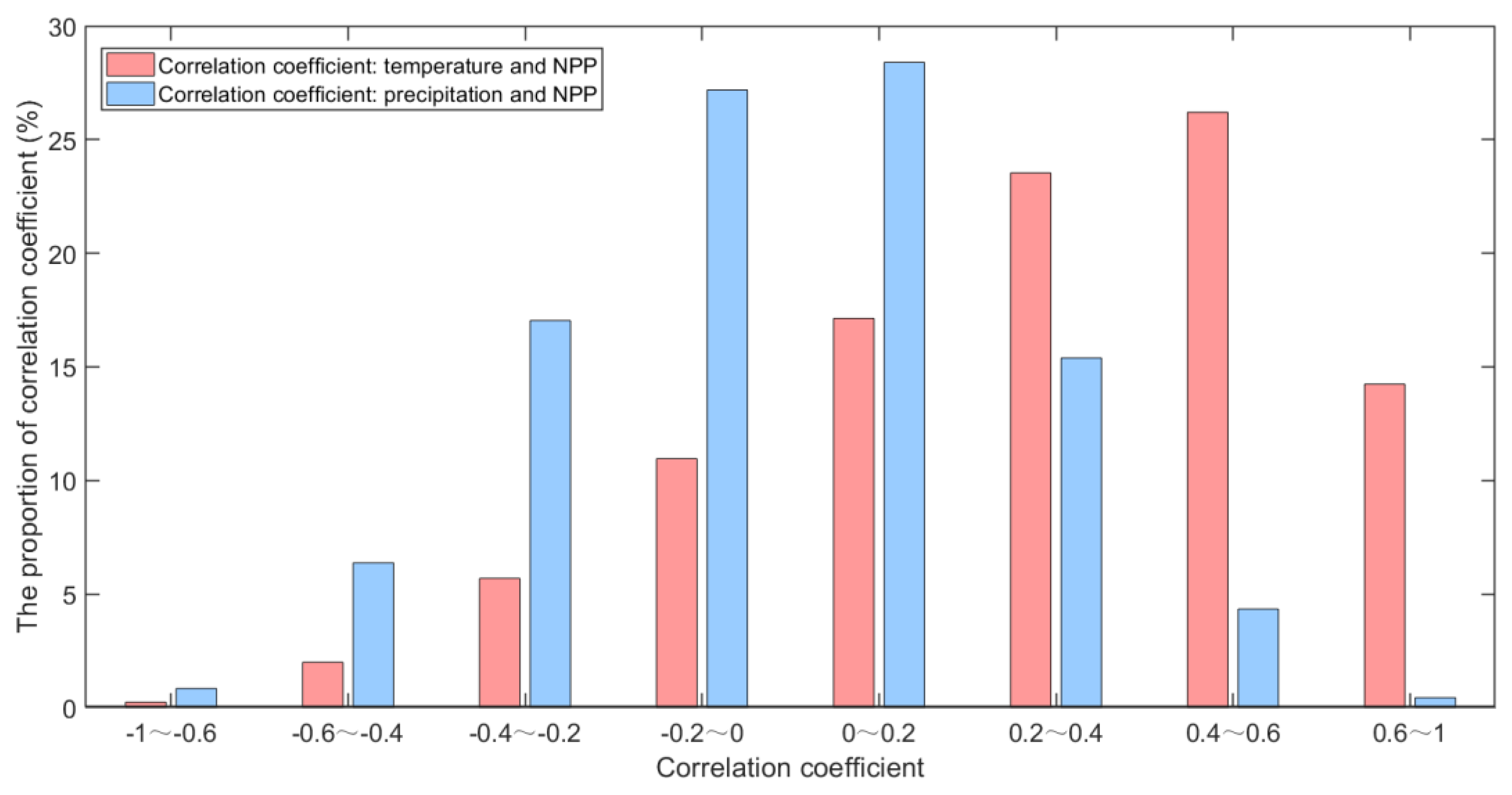
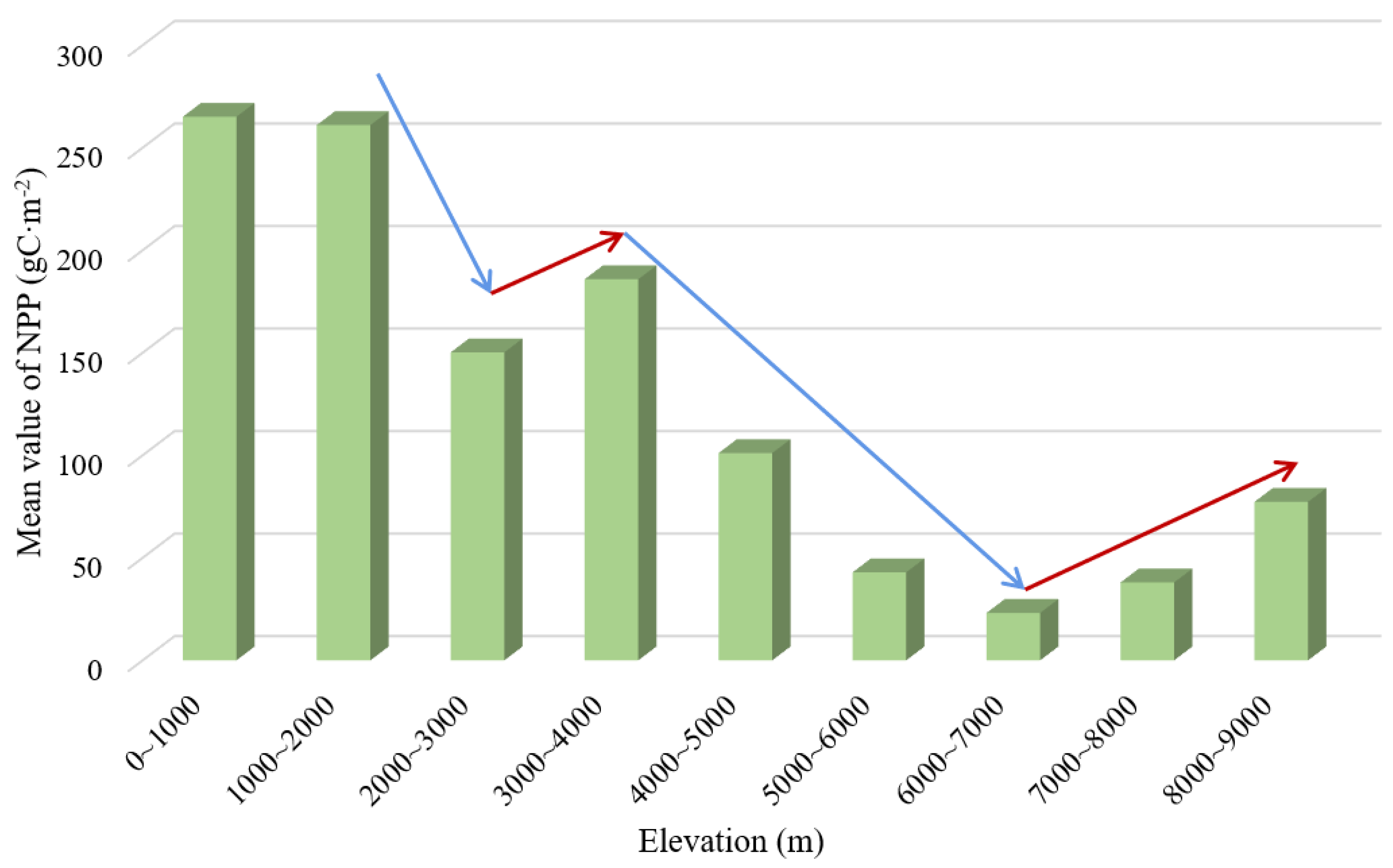
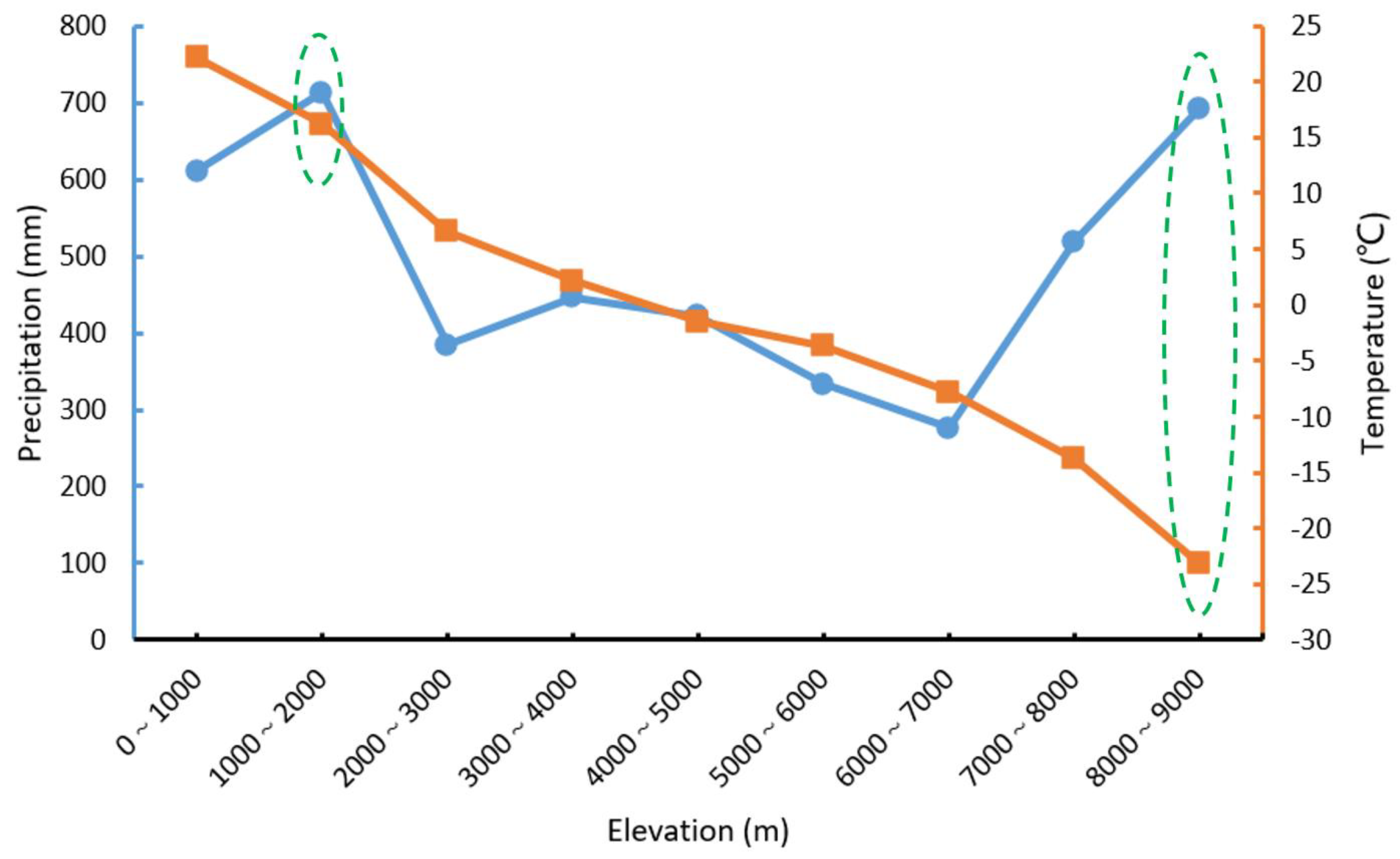
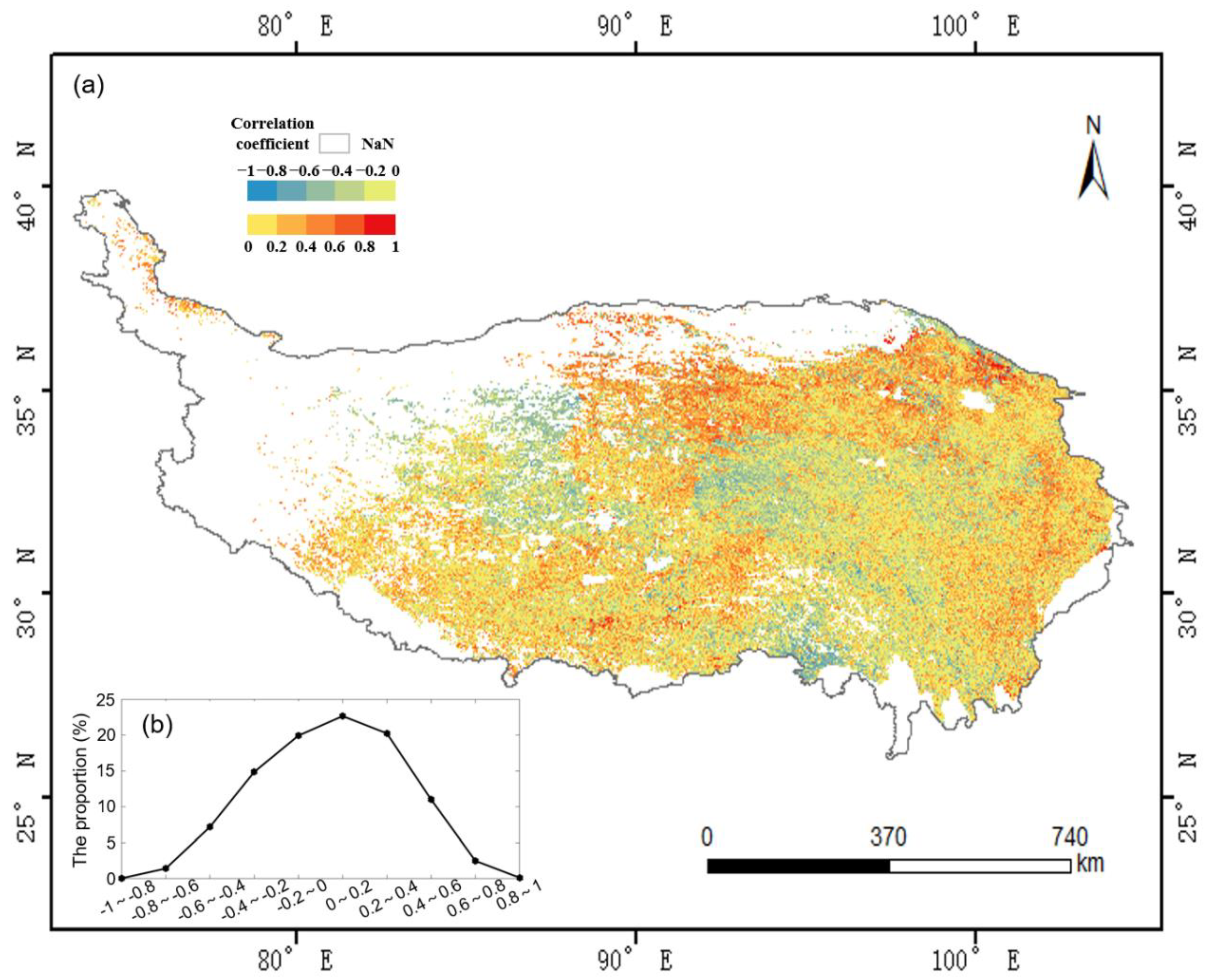
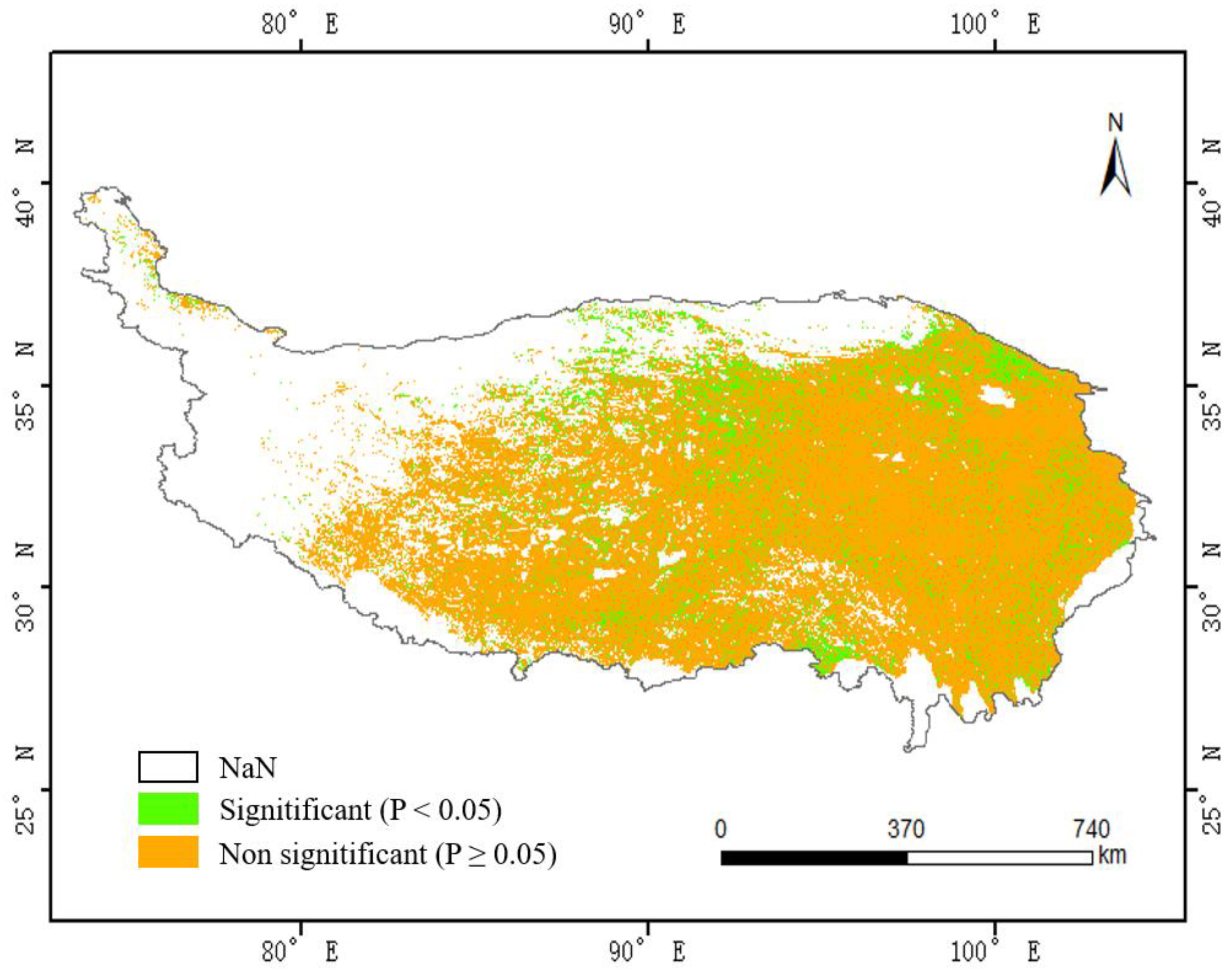
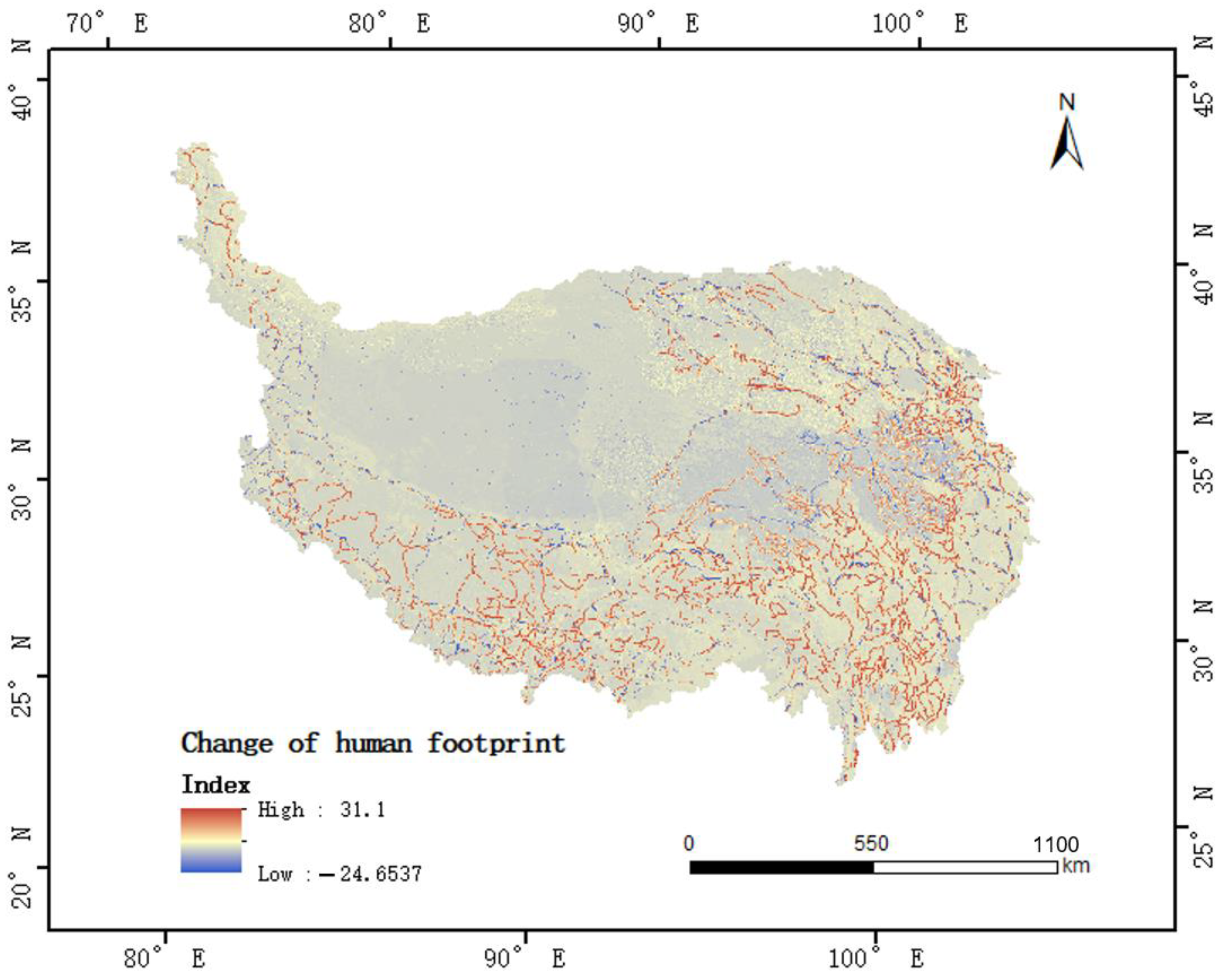
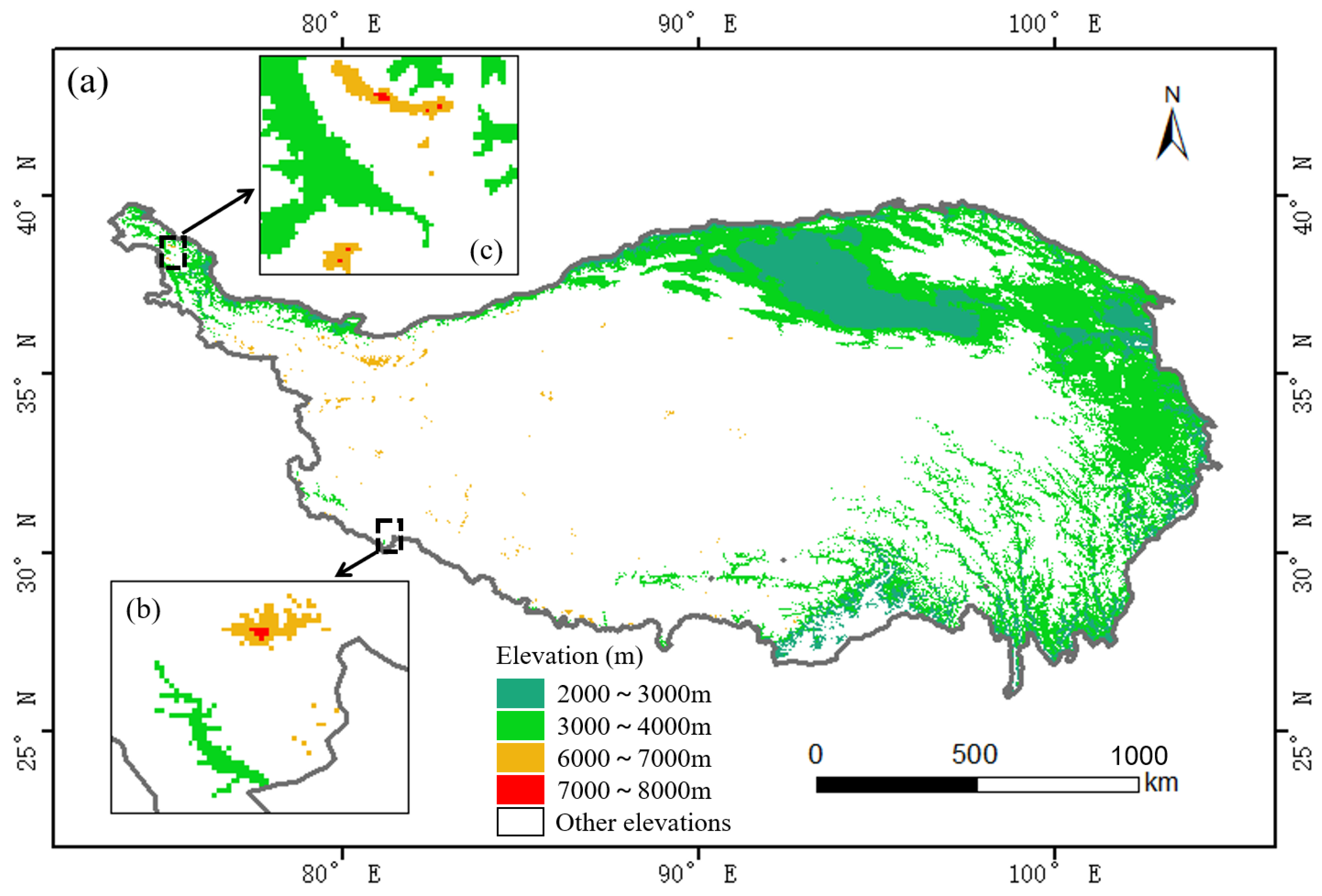
| Region | Trend (gC·m−2·yr−1) | Significance | Goodness of Fit (R2) | Root Mean Squared Error (RMSE) (gC·m−2) | Mean (gC·m−2) |
|---|---|---|---|---|---|
| Total region | 0.345 | p = 0.42 | 0.0441 | 7.8653 | 217.57 |
| Desert | 0.8127 | p < 0.05 | 0.4424 | 4.4698 | 74.17 |
| Grassland | 1.9177 | p < 0.05 | 0.4708 | 9.9612 | 221.16 |
| High-cold vegetation | 0.5788 | p = 0.07 | 0.2079 | 5.5342 | 112.85 |
| Broad-leaved forest | −0.633 | p = 0.50 | 0.0313 | 17.2538 | 442.52 |
| Mean (gC·m−2) | Trend ((gC·m−2)/yr) | Coefficient of Variation (CV) | |||
|---|---|---|---|---|---|
| Range | Proportion (%) | Range | Proportion (%) | Range | Proportion (%) |
| 0 | 34.9 | <−50 | 2.2 | 0 | 34.9 |
| 0 ~ 200 | 41.3 | −50 ~ −25 | 1.1 | 0 ~ 0.06 | 2.9 |
| 200 ~ 300 | 9.3 | −25 ~ 0 | 8.9 | 0.06 ~ 0.08 | 8.7 |
| 300 ~ 400 | 6.4 | 0 | 39.9 | 0.08 ~ 0.1 | 12.7 |
| 400 ~ 500 | 2 | 0 ~ 10 | 29.5 | 0.1 ~ 0.12 | 13 |
| 500 ~ 800 | 3.3 | 10 ~ 20 | 10.9 | 0.12 ~ 0.14 | 10.5 |
| 800 ~ 1000 | 1.4 | 20 ~ 30 | 3.9 | 0.14 ~ 0.16 | 7 |
| >1000 | 1.4 | >30 | 3.6 | >0.16 | 10.3 |
| Region | Trend (mm/yr) | Significance | R2 | RMSE (mm) | Mean (mm) |
|---|---|---|---|---|---|
| Total region | 4.69 | p = 0.05 | 0.2311 | 41.93 | 418.75 |
| Desert | 4.29 | p = 0.07 | 0.201 | 41.94 | 123.91 |
| Grassland | 6.41 | p < 0.05 | 0.3142 | 46.41 | 366.94 |
| High-cold vegetation | 3.69 | p < 0.05 | 0.2957 | 27.88 | 452.54 |
| Broad-leaved forest | 4.38 | p = 0.32 | 0.0649 | 81.38 | 731.6 |
| Region | Trend (°C/yr) | Significance | R2 | RMSE (°C) | Mean (°C) |
|---|---|---|---|---|---|
| Total region | 0.0509 | p < 0.05 | 0.3022 | 0.379 | 1.07 |
| Desert | 0.0872 | p < 0.05 | 0.2509 | 0.7379 | −0.76 |
| Grassland | 0.0254 | p = 0.19 | 0.1114 | 0.3509 | −1.12 |
| High-cold vegetation | 0.0493 | p < 0.05 | 0.269 | 0.3981 | −1.23 |
| Broad-leaved forest | 0.0419 | p < 0.05 | 0.2556 | 0.3499 | 7.4 |
| Temperature | Precipitation | |||
|---|---|---|---|---|
| Correlation Coefficient | Significance | Correlation Coefficient | Significance | |
| Total region | 0.578 * | p < 0.05 | −0.314 | p = 0.22 |
| Desert | 0.164 | p = 0.53 | 0.19 | p = 0.46 |
| Grassland | 0.629 ** | p < 0.01 | 0.17 | p = 0.51 |
| High-cold vegetation | 0.787 ** | p < 0.01 | −0.416 | p = 0.10 |
| Broad-leaved forest | 0.458 | p = 0.06 | −0.543 * | p < 0.05 |
Publisher’s Note: MDPI stays neutral with regard to jurisdictional claims in published maps and institutional affiliations. |
© 2021 by the authors. Licensee MDPI, Basel, Switzerland. This article is an open access article distributed under the terms and conditions of the Creative Commons Attribution (CC BY) license (https://creativecommons.org/licenses/by/4.0/).
Share and Cite
Zhang, Y.; Hu, Q.; Zou, F. Spatio-Temporal Changes of Vegetation Net Primary Productivity and Its Driving Factors on the Qinghai-Tibetan Plateau from 2001 to 2017. Remote Sens. 2021, 13, 1566. https://0-doi-org.brum.beds.ac.uk/10.3390/rs13081566
Zhang Y, Hu Q, Zou F. Spatio-Temporal Changes of Vegetation Net Primary Productivity and Its Driving Factors on the Qinghai-Tibetan Plateau from 2001 to 2017. Remote Sensing. 2021; 13(8):1566. https://0-doi-org.brum.beds.ac.uk/10.3390/rs13081566
Chicago/Turabian StyleZhang, Yin, Qingwu Hu, and Fengli Zou. 2021. "Spatio-Temporal Changes of Vegetation Net Primary Productivity and Its Driving Factors on the Qinghai-Tibetan Plateau from 2001 to 2017" Remote Sensing 13, no. 8: 1566. https://0-doi-org.brum.beds.ac.uk/10.3390/rs13081566






